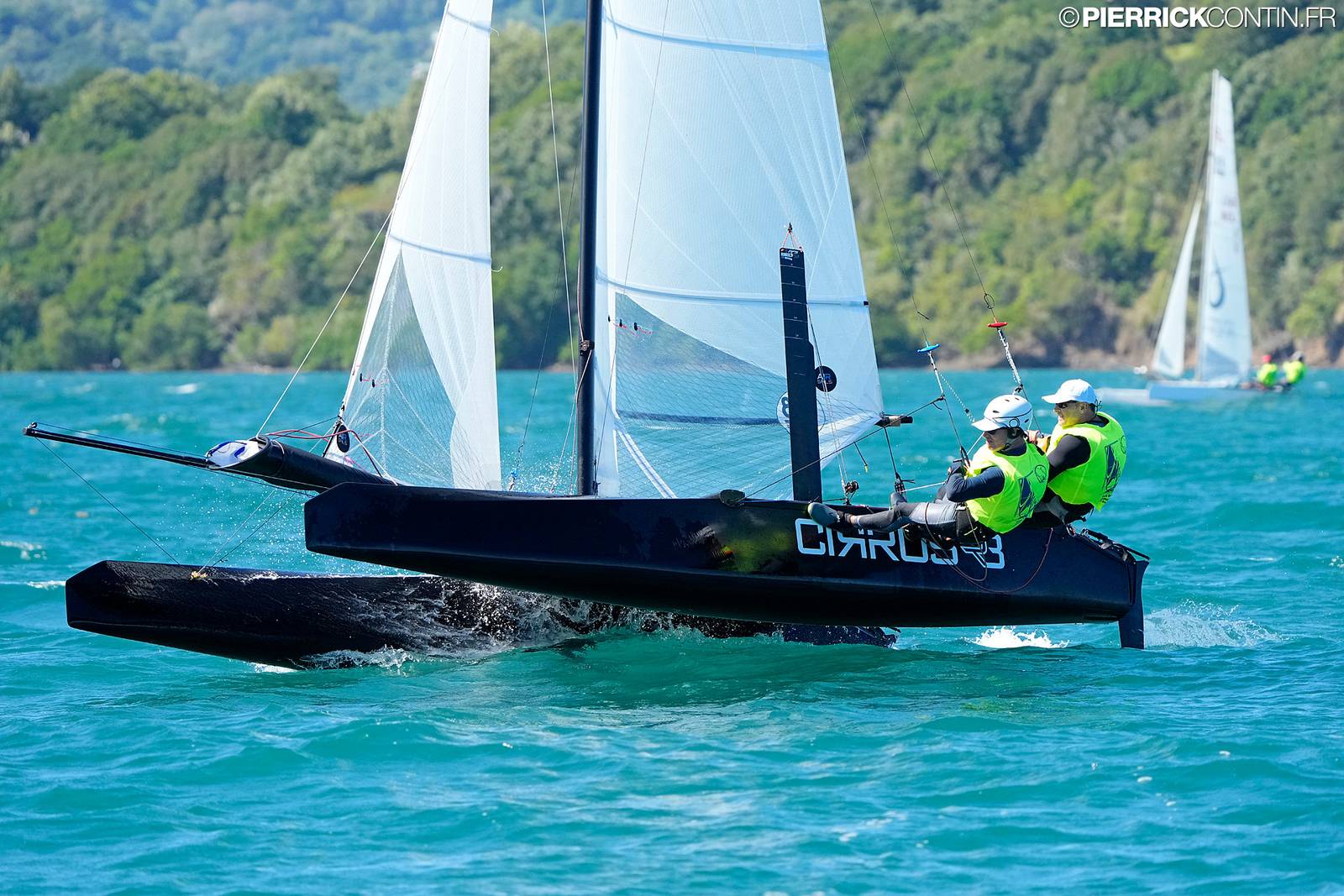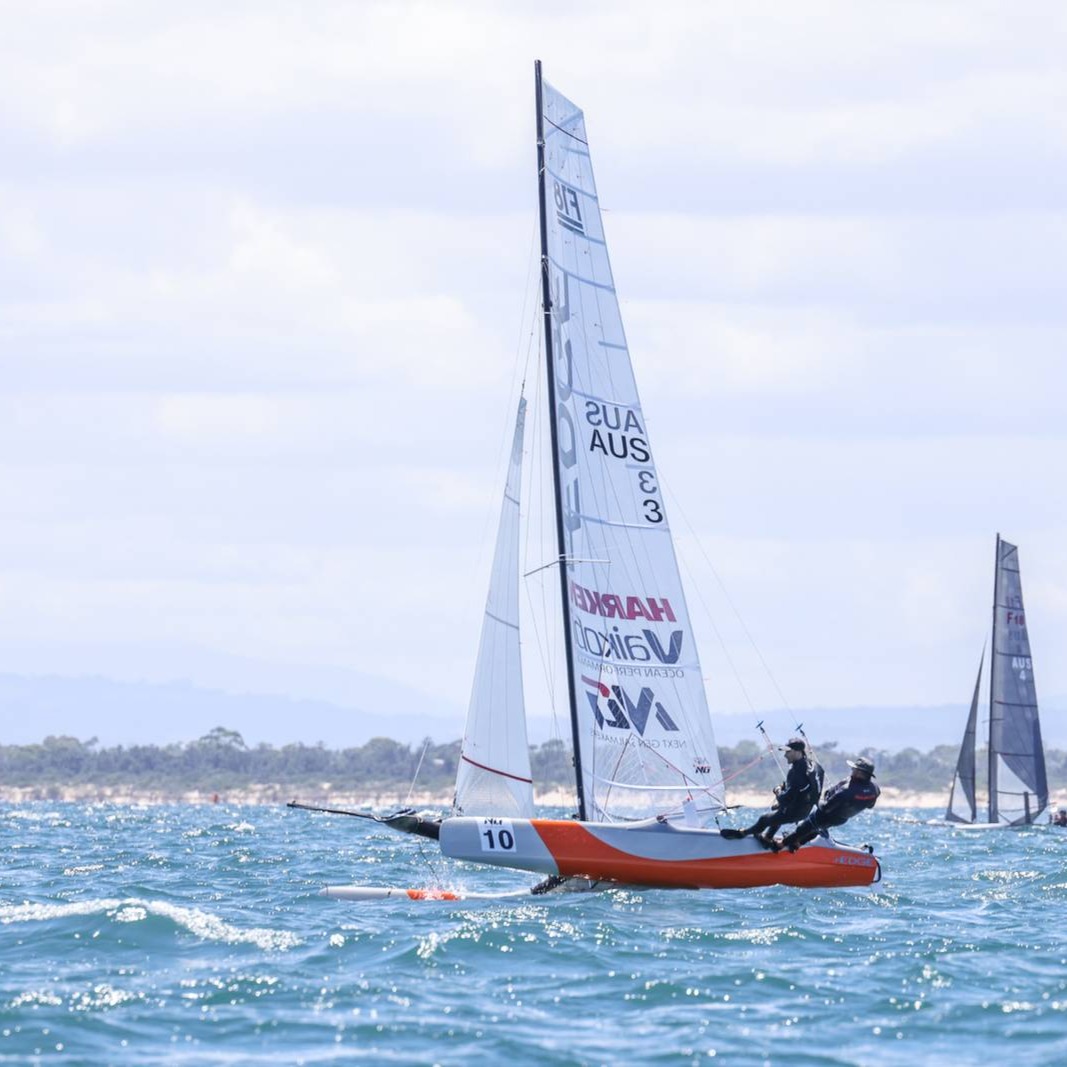A-Class: Takapuna outcomes by Dario Valenza
Too much ‘radio noise’ , including my thoughts on the matter, so as always it’s better lo read directly what the guys putting the hours building the boats are thinking.
“Dear Class President,
Being a relatively new participant in the A Class, I thought it right to refrain from supporting either position prior to the vote on Rule 8. It seemed to me that those entering the Class do so accepting the rules. Being fast while staying inside rule constraints is part of the challenge.
Moreover, having invested as a manufacturer in developing a boat within the existing rule, any advocacy for or against a change could have been viewed as serving a commercial interest.
While I still believe that it is not my role to promote an outcome, certain facts have emerged in the lead-up to and during the Worlds that point to a change being necessary to keep the Class healthy – Something I certainly do have an interest in.
It has become inescapable that Rule 8, as currently worded, has failed to achieve the intended outcome. It follows that it should be either tightened with clearer wording or deleted.
Which option will best serve the Class is a matter for debate. However the dilemma of the legislator teaches us that a revised wording is likely to also fail: Any wording chosen to expresses an intent in the mind of the writer will be tested by being applied ‘to the letter’ by those responsible for enforcing the rule (in law this is the gulf between the legislative and the judicial). The writer is not able to conceive of every possible application of the chosen wording that could circumvent the intent. We cannot today write a rule that prevents some future unforeseen technology achieving what we seek to prohibit. This is because we cannot with simple wording
cover eventualities that have not yet been invented.
It should be noted that this is true for any rule with a specific intended ‘functional’ outcome. There is a fundamental difference between this type of rule and absolute dimensional limits such as maximum length, beam and sail area.
In other sports, when a solution emerges that ‘works around’ a rule, it is accepted in the short term since the competitor who devised it has a right to benefit from his inventiveness. But at the end of the relevant competition the rule is revised. More often than not it is deleted since what it had sought to prohibit has become inevitable, more accessible, cheaper etc.
I believe this is the case with the A Class now: the rewards of foiling are so great that designers and sailors will seek to achieve it ‘at any cost’. This cost will always be greater when part of it is devoted purely to work around a rule. The extra cost is an unnecessary barrier to entry into the Class. And an unnecessary barrier to upgrading existing boats in order to keep them competitive.
The current rule does not prevent foiling. It only makes foiling more expensive and less controllable.
Since the necessary foil area and span is today smaller than had been anticipated and is trending toward being smaller still, limitations on span will become less relevant. With the present analysis tools and construction technology, the ideal foil would have some 180mm root chord and 600mm span. In future these dimensions are likely to decrease. Forcing a lower aspect ratio, as the rule currently does, simply reduces efficiency without really changing the performance envelope.
The real harm caused by the present rule is the peculiar difficulty it creates in installing a stable setup. Stability in heave is the single most important factor in ease of handling. It was the inherent lack of stability in heave that made foiling on J boards so challenging and risky.
A foiler that is stable in heave will be safer and more forgiving to sail than an equivalent displacement or foil-assisted boat. This can be shown to be objectively true, in the face of fears, preconceptions and armchair speculation: the physics is well understood. At the risk of stretching a comparison, it can be said that you trust your life to stable foil geometries whenever you board a commercial airline flight.
A stable foiling setup on a sailboat has the ability to push back progressively harder against increasing rig forces that tend to bury the bow and could otherwise ‘unsaddle’ you when hull buoyancy runs out. Being clear of the waves also helps. A stable foiling setup has not yet been raced in the A Class, but it has been tried and shown to work in testing.
Among the things we tested in 2013 was a series of L/V foils with ‘tip up’ angles of 10, 15, 20 and 30 degrees. Inserted from below with the horizontal foil having spans of 600 and 500mm with a root chord of 140. The reason we did this was to get a baseline measurement for uncompromising foiling performance so that we could properly evaluate S, J and our proposed (at the time) ‘comma’ foils.
We did not adopt a rule legal variant of the L/V foils for the Worlds mainly due to a concern about not having the necessary time to perfect the systems to make them race-ready. Part of the decision was a concern over the (at the time) untested legality of large removable foil cases and a desire to keep things simple (and cheap) to build and maintain.
After the Worlds it is clear that these reasons are not sufficient to keep ignoring a full foiling solution.
For the information of the members, here are some of the observations we made during tests of a stable three foil arrangement:
The boat sat comfortably at a 400mm ride height from 6-8 to 15-20 knots TWS. Downwind this could be achieved without trapezing since full righting moment was available. Downwind speed was comparable to a foil assisted boat but depth was significantly better. Upwind there was no measurable difference when ‘skimming’. Foiling upwind meant sailing 5 degrees lower with much better speed but VMG gains were marginal so I would say ‘inconclusive’.
With anything more than 20 degrees of tip up, the boat was completely predictable. Even ‘too safe’. So 10-15 degrees should be enough for comfortable reasonably stable flight. Naturally the smaller the tip up angle, the smaller the drag penalty required to achieve stability.
We had rake adjustment on the foils but it did not seem necessary to operate it in real time. Stability in heave comes from the tip up angle. The longer the foil span, the more pronounced this effect.
Installing L/V foils within the rule is possible but requires unnecessary complexity such as large foil ‘cases’, articulating foils or leeboard arrangements.
L/V foils designed within the current rule will also suffer from four sources of additional drag: 1) Aspect ratio of the horizontal foil will be very low so induced drag will be high. 2) A bigger tip up angle will be necessary for a given stability because the influence of the vertical near the root will be extend over a greater percentage of the area of the horizontal. 3) Cant angle of the vertical and hence the lift share it contributes will be limited. 4) When not foiling, interference drag at the root will be higher because the foil will have to be located very far outboard at the turn of the bilge so the included angle between hull and foil will be more acute.
It seems that despite these compromises, the performance and (crucially) the exploitability of a foiling boat will make the advantages too attractive to pass up. From what we saw at the Worlds, foil drag is a price worth paying if it allows you to ‘pop’ earlier. But this puts an even bigger premium on heave stability since the aggressive lift must be toned down once flying. This was an issue for some at the Worlds. J foils and our current comma foils have given tantalising glimpses of the future, but they are only the beginning.
To sum up, the rule adds barriers to stable foiling in the form of drag, complexity and cost. However the promise shown by even unstable foiling configurations at the Worlds tells us that the advantage of ‘proper’ foiling will outweigh the penalties. Even under Rule 8! People will put energy into it and make it work and it will be fast enough to render the alternatives uncompetitive.
In our experience stable foiling can be exploited by anyone who can get around the course on a ‘normal’ A. Once ‘popped’ the boat can be sailed quite conservatively in relative safety. The Worlds have shown that unstable setups are not so accessible. So why keep a rule that makes stability harder and more expensive to achieve?
Make no mistake: the choice now under Rule 8 is only between stable and unstable foiling. No other solution has a prayer. The more desirable option being artificially more expensive. It would seem logical to make a proven inevitable development cheaper, simpler, more accessible and safer.
Regarding fore-and-aft foil position, we have found it to be far less critical than predicted. Moving the foils forward improves stability in theory but in practice the available range of CG positions appears sufficient to get stability even with foils aft in a conventional location. In fact, in our experience the compromise in tacking performance was far more ‘expensive’ in terms of seconds around the course than any small improvement conferred to heave stability. This may change with refinement and foiling tacks, but for now retaining a traditional foil location does not appear to be a deal breaker.
I would bet that putting an L/V foil in the existing foil case of any current boat would be enough of an improvement to keep that boat roughly in its current position in the fleet. Obviously if the boat has C foil cases then the new foils must be a C with an L/V horizontal tacked on. For this to work the exclusion zone has to be deleted. This is a compromise that will avoid the need for major ‘carbon surgery’ for those who want to try stable foiling without making a full commitment. Most boats should be structurally able to handle it provided a decent strong point is added on deck to secure the foil down line.
In conclusion, the current situation is that we have an ‘intent based’ rule that is additional to the fundamental box constraining the open A Class. This rule has effectively been circumvented. The toll for working around Rule 8 is extra cost, complexity and additional difficulties in converting older boats to a configuration that is faster and safer. It makes little sense to retain the rule in its current form.”





























I just heard that my great sailing friend and former CEO of Hobiecat Europe has passed. May The endless oceans…
...Report was sent by an F18 Sailor, if you want Hobies reported send your own, we'll publish as usual. Cheers.
Looks like in your report the Hobies are not really present. Suggest to rewrite the article.
Thanks for the great report Wik. Great battle.
If I correctly read the results the overall winner this year is a Hobie16